How Does Bekey Filters Clean When Tankwater Level Is Half Full
Rainwater Harvesting 101
Got a Question about Rainwater Harvesting? Ask it here.
What is Rainwater Harvesting?
Rainwater harvesting is collecting the run-off from a construction or other impervious surface in order to store information technology for later utilize. Traditionally, this involves harvesting the pelting from a roof. The rain will collect in gutters that channel the water into downspouts so into some sort of storage vessel. Rainwater collection systems can be as simple as collecting rain in a rain butt or as elaborate equally harvesting rainwater into large cisterns to supply your entire household demand.
The idea of rainwater harvesting usually conjures up images of an former farm cistern or thoughts of developing countries. The reality is that rainwater harvesting is becoming a viable alternative for supplying our households and businesses with h2o. Information technology's not just for the subcontract anymore! There are many countries such as Germany and Commonwealth of australia where rainwater harvesting is a norm. Due to the green edifice movement, y'all will be seeing rainwater harvesting systems become more popular here in America.
The collection of rainwater is known by many names throughout the earth. Information technology ranges from rainwater drove to rainwater harvesting to rainwater catchment. In improver, terms such as roofwater collection or rooftop h2o collection is also used in other countries.
We believe that rainwater harvesting is a feasible applied science in an urban setting. All that is necessary to take advantage of this resources is to capture the costless h2o falling on your roof and direct it to a rainwater storage tank. By doing this, y'all tin take control of your h2o supply and replace all or at least a substantial portion of your water needs. Rainwater harvesting systems can be configured to supply your whole business firm and/or your mural needs.
What are the Benefits of Rainwater Collection?
- Rainwater is a relatively clean and absolutely free source of water
- Yous have total command over your water supply (ideal for cities with water restrictions)
- It is socially acceptable and environmentally responsible
- It promotes self-sufficiency and helps conserve water
- Rainwater is meliorate for mural plants and gardens because it is not chlorinated
- It reduces stormwater runoff from homes and businesses
- It can solve the drainage bug on your property while providing you with free water
- It uses simple technologies that are inexpensive and piece of cake to maintain
- It can exist used as a main source of h2o or as a dorsum upward source to wells and municipal water
- The system can exist easily retrofitted to an existing construction or built during new home construction
- System are very flexible and can be modular in nature, allowing expansion, reconfiguration, or relocation, if neccesary
- Information technology can provide an splendid back-up source of h2o for emergencies
Not enough benefits for you? Discover more than rainwater harvesting advantages.
Why is Rainwater Harvesting Important?
Rainwater harvesting is of import for several reasons only one of the biggest is the fact that we are tapping out water conservation gains within our homes and then we need to first looking outdoors for more opportunities.
The following graph shows the gains that take been achieved with our indoor h2o fixtures through the combination of governmental standards and innovation past fixture companies. As y'all can see, we don't take much more than room to become in terms of achieving more than efficiency gains with our indoor fixtures. What's next… the 0.2 gallon per flush toilet? Probably not!
This phenomenom is known as the law of diminishing returns. Then where will the side by side revolution in water conservation take place? We believe nosotros offer services in the areas where this revolution will take place.
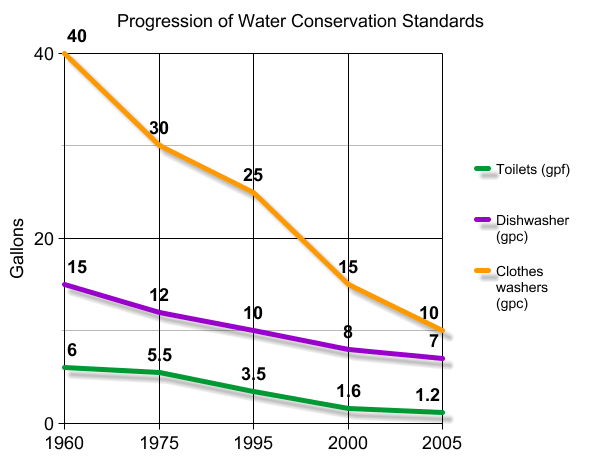
What are the uses of collected rainwater?
You can essentially use rainwater anywhere you utilize tap water. The idea of using drinking water to flush our toilets and water our lawns is wasteful and irresponsible, particularly in light of population growth and water shortages beyond the country. Rainwater collection is a technique to dark-green your home and to lessen your environmental footprint.
There are basically three areas where rainwater can exist used:
- Irrigation use
- Indoor, non-beverage use
- Whole house, potable use
Here are some ideas for specific uses of rainwater:
- Manus water your backyard and garden
- Connect rainwater drove organization to irrigation/sprinkler organisation
- Wash your vehicles
- Wash your pets
- Refill your fountains and fish ponds
- Refill your swimming pool
- Replace the use of tap water with rainwater to wash your driveways and sidewalks (if you don't use a broom)
- Employ it for all indoor non-drink fixtures (toilets and apparel washer)
- Apply it for all potable needs when properly filtered and disinfected
- Utilize it for industrial processes instead of municipally treated h2o
So merely how much rain can I collect?
The amount of rainfall that you lot tin collect is governed by the following formula:
1″ of pelting ten 1 sq. ft. = 0.623 gallons
To calculate the amount of rainwater you tin can collect, you need to know your almanac average atmospheric precipitation for your area. Y'all tin can use the atmospheric precipitation map below to find an approximate amount for your area.
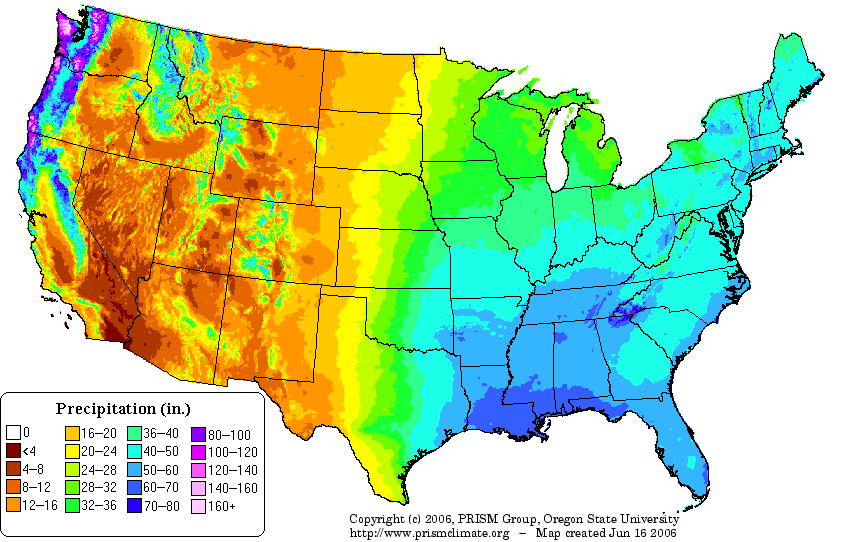
How to harvest rainwater
So you're convinced that you desire to get-go collecting rainwater at your house. Beneath yous will find the resources to educate yourself on the best method for harvesting rainwater in your state of affairs. You volition also find information about the basic components of a rainwater collection system. Even though rainwater catchment is an erstwhile technology, in that location have been many improvements over fourth dimension through product innovations.
What are the dissimilar methods to collect rainwater?
The simply thing that differs in the following methods is the scale of the system. They all follow the same principles but differ on aesthetics and actual h2o conservation effectiveness. Click the pictures for a closer wait.
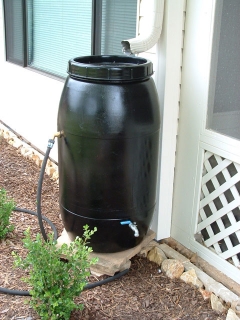
Pelting barrels can get you lot started
Pelting Barrels
This method is the most common and one that many people are familiar with. This involves installing a barrel at a gutter downspout to collect rainwater. The actual barrel may be a recycled butt or a new commercially available rain barrel.
Pros:
- Hands implemented by anyone at whatever residence
- Barrels are readily available in your community or at various stores & websites
- Barrels don't accept up much space and so they can fit into any situation
Cons:
- Capacity is generally only l to 100 gallons
- Easily overflows and wastes drove opportunities
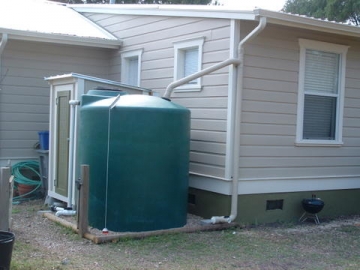
Moving upwardly in the world...
"Dry" Organisation
This method is a variation of a rain barrel ready-upward, but it involves a larger storage volume. Essentially, the drove pipe "drys" later on each rain event since it empties directly into the top of the tank.
Pros:
- Tin store a big amount of rainwater
- Neat for climates where rainfall happens with infrequent, larger tempest events
- Can be inexpensive to implement
- Less complicated system then maintenance is easier
Cons:
- The storage tank must be located next to your business firm

Now yous are talking!
"Wet" Organization
This method involves locating the collection pipes clandestine in guild to connect multiple downspouts from different gutters. The rainwater volition fill up the clandestine piping and the water will rise in the vertical pipes until information technology spills into the tank. The downspouts and underground drove piping must take water-tight connections. The elevation of the tank inlet must be below the lowest gutter on the house.
Pros:
- The ability to collect from your entire collection surface
- The ability to collect from multiple gutters and downspouts
- The tank can be located away from your house
Cons:
- More than expensive to implement due to underground pipage
- Sufficient difference between gutters and tank inlet must exist bachelor
How do I create a complete rainwater collection arrangement?
The image beneath shows a consummate rainwater drove arrangement. While some of the components shown are absolutely necessary, not all of the components listed are required. Although, all of these components will assistance create a harvesting system that is highly functional and about maintenance-free.
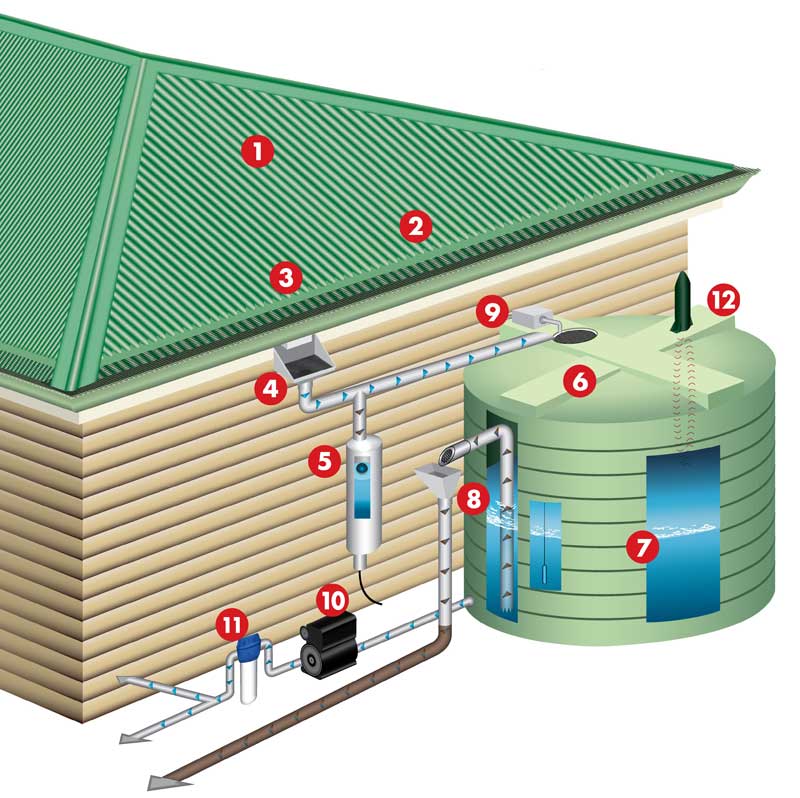
- It all starts with yourROOF SURFACE. Most all roof surfaces are fine for rainwater harvesting.
- Your gutters should have some sort of GUTTER PROTECTION SCREENINM in order to keep large debris from inbound the gutters.
- You can collect rainwater from whatever type and shape of GUTTER. Yous do non demand a special gutter for harvesting rainwater.
- An additional filtration opportunity is with the installation of a RAIN HEAD (downspout filter) that allows for a bit of self-cleaning filtration options.
- A Commencement-Affluent DIVERTER helps to prevent the commencement flush of contaminated rainwater from entering the tank.
- Another rainwater filtration opportunity is with a TANK SCREEN that is installed on the tank entry point. It also helps to keep mosquitoes and pests out.
- RAINWATER TANKS come in all sorts of sizes and materials. Click to learn more well-nigh all the various types of rainwater harvesting tanks bachelor on the marketplace.
- Install an INSECT PROOF FLAP VALVE on the end of the overflow pipage to keep mosquitoes and pests out.
- An Machine-Fill up Arrangement can be installed to keep a minimum corporeality of water in the tank at all times. This is very important for rainwater tanks that are connected to automatic irrigation systems in gild to prevent the pump from running dry.
- Select a PUMP Organisation to provide pressurized rainwater to distribute the rainwater easier or to connect to an inground irrigation organization.
- Install an IRRIGATION FILTER inline after the pump in order to catch whatsoever large debris that may have gotten through the pump.
- A WATER LEVEL INDICATOR tin can be helpful with monitoring the water usage from the tank. Those are available in simple gauge tank options along with wireless digital options.
Latest Rainwater Harvesting FAQ



Source: https://www.watercache.com/education/rainwater-harvesting-101
Posted by: costablospas.blogspot.com


0 Response to "How Does Bekey Filters Clean When Tankwater Level Is Half Full"
Post a Comment